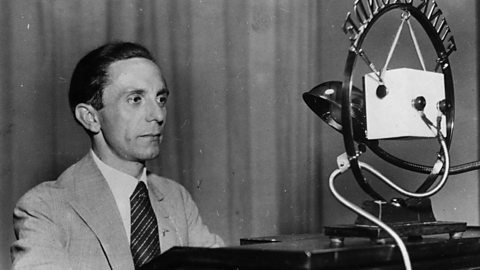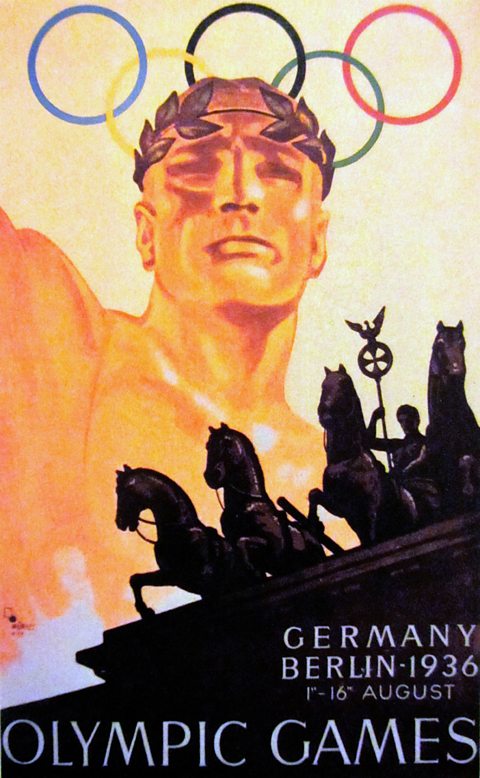Nazi propaganda and control of the arts

Joseph Goebbels
Hitler and the Nazi Party were a constant presence in the life of the German people, with:
- The infamous Swastika symbol appearing on every government uniform and public building.
- Pictures of Hitler displayed everywhere.
- Germans having to greet each other with a ÔÇśHeil HitlerÔÇÖ raised arm salute.

The government department responsible for all of this was the Ministry of Enlightenment and Propaganda, headed by Dr Joseph Goebbels. It aimed to brainwash people into obeying the Nazis and idolising Hitler. Its methods included:
- Censorship of the press. All newspapers were controlled by the government and could only print stories favourable to the Nazi regime.
- Control of radio broadcasts. Radios were sold very cheaply so that most Germans could afford one. All radio output was controlled by GoebbelsÔÇÖ ministry through the Reich Broadcasting Corporation.
- Mass rallies. These public displays of support for Nazism involved music, speeches and demonstrations of German strength. The biggest one was held each year in August at Nuremberg.
- Use of sports events. Berlin hosted the Olympics of 1936, which the Nazis used as an opportunity to showcase the success of the regime and to demonstrate the superiority of the AryanA person of European descent - not Jewish - often with blond hair and blue eyes. The Nazis viewed Aryans as the superior human race. race. The victories of the African-American athlete Jesse Owens for the USA infuriated the Nazi leadership.
Loudspeakers in public places also blared out Nazi propaganda. Much of the information Germans received reinforced the message of Aryan racial superiority whilst demonising the Jews and other ÔÇśenemiesÔÇÖ of the regime.
Nazi control of culture and the arts
| Type | German influence |
| Art | The Weimar period had seen a flourishing of German art, much of which was abstract. Hitler saw this modern art as ÔÇśdegenerateÔÇÖ and over 6500 works of art were removed from display across Germany. Hitler encouraged ÔÇśAryan artÔÇÖ instead, which showed the physical and military power of Germany and the Aryan race. |
| Architecture | Hitler was very interested in architecture and believed it could be used to project the power of the Nazi regime. The most important architect of the period was Albert Speer, who redesigned Berlin, as well as designing the stadium in Nuremberg where annual rallies were held. |
| Literature | Nazis ceremonially burned thousands of books in 1933 that were viewed as being subversive or as representing ideologies opposed to Nazism. These included books written by Jewish, pacifist, classical, liberal, anarchist, socialist, and communist authors. |
| Theatre | Works by certain playwrights were banned. Nazi-produced political plays and musicals were not very popular so the regime allowed classic plays by the likes of Shakespeare to be performed. |
| Film | To make sure that film served the goals of propaganda, the Nazi Party gradually took over film production and distribution. A state-run professional school for politically reliable film-makers was founded, and membership of an official professional organization (Reichsfilmkammer) was made compulsory for all actors and film-makers. The Nazi leaders often used film stars, like Lil Dagover, to help promote the popularity of the party in Germany. |
| Music | In classical music, works by Jewish composers like Mendelssohn and Mahler were banned and the works of the German composer Wagner were promoted, gaining huge popularity. The Nazis were strongly opposed to jazz music, which they referred to as 'Negro music' and called it 'degenerate'. |
| Art | |
|---|---|
| German influence | The Weimar period had seen a flourishing of German art, much of which was abstract. Hitler saw this modern art as ÔÇśdegenerateÔÇÖ and over 6500 works of art were removed from display across Germany. Hitler encouraged ÔÇśAryan artÔÇÖ instead, which showed the physical and military power of Germany and the Aryan race. |
| Architecture | |
|---|---|
| German influence | Hitler was very interested in architecture and believed it could be used to project the power of the Nazi regime. The most important architect of the period was Albert Speer, who redesigned Berlin, as well as designing the stadium in Nuremberg where annual rallies were held. |
| Literature | |
|---|---|
| German influence | Nazis ceremonially burned thousands of books in 1933 that were viewed as being subversive or as representing ideologies opposed to Nazism. These included books written by Jewish, pacifist, classical, liberal, anarchist, socialist, and communist authors. |
| Theatre | |
|---|---|
| German influence | Works by certain playwrights were banned. Nazi-produced political plays and musicals were not very popular so the regime allowed classic plays by the likes of Shakespeare to be performed. |
| Film | |
|---|---|
| German influence | To make sure that film served the goals of propaganda, the Nazi Party gradually took over film production and distribution. A state-run professional school for politically reliable film-makers was founded, and membership of an official professional organization (Reichsfilmkammer) was made compulsory for all actors and film-makers. The Nazi leaders often used film stars, like Lil Dagover, to help promote the popularity of the party in Germany. |
| Music | |
|---|---|
| German influence | In classical music, works by Jewish composers like Mendelssohn and Mahler were banned and the works of the German composer Wagner were promoted, gaining huge popularity. The Nazis were strongly opposed to jazz music, which they referred to as 'Negro music' and called it 'degenerate'. |
The NazisÔÇÖ interest in and influence on all of these areas demonstrates the extent to which the party sought to control German life and win over the population to the Nazi cause.